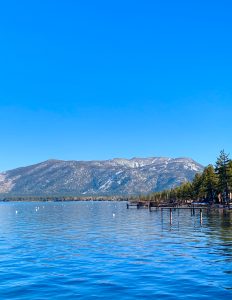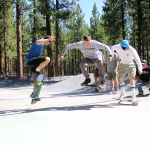Wildfire resilience requires active forest management – not a hands-off approach (Opinion)
In the summer of 2021, the Caldor Fire roared over the Sierra Nevada crest and into South Lake Tahoe. Thankfully, proactive forest treatments including strategic thinning of dense trees, controlled burns, and defensible space allowed firefighters to slow the flames and save neighborhoods. Local fire officials noted that when the crown fire hit areas where fuels were reduced, the fire intensity greatly diminished, dropping from 100-foot flames in the treetops down to the ground, giving firefighters the room they needed to safely suppress the flames. Far from making fires worse, these science-based forest management actions clearly protected the community.
The proposed Fix Our Forests Act (FOFA) supports these types of proactive forest management activities. Critics argue that thinning forests opens them up to more wind and that wildfires spread fastest in thinned, open forests; they claim FOFA guts environmental protections, implying we should leave forests alone and focus solely on home hardening. As residents and fire professionals of the fire-prone Sierra, we should be wary of such one-sided arguments. “The overwhelming scientific evidence and on-the-ground experience show that proactive forest management reduces wildfire severity and helps protect communities, especially when paired with home hardening and defensible space,” says Amy Berry, CEO of the Tahoe Fund.
For thousands of years, Indigenous tribes across the West have been the original stewards of our forests, using fire intentionally and skillfully to shape resilient landscapes, promote biodiversity, and reduce fuel loads. Far from being untouched wilderness, Western forests have evolved alongside and because of human intervention. Today, science confirms what Native communities have long known: thoughtful, proactive forest health treatments such as thinning and prescribed fire will restore ecological balance without increasing wildfire severity. In fact, these treatments are essential tools for reducing the risk of catastrophic fires, protecting communities, and honoring traditional knowledge that has sustained these ecosystems for millennia.
By selectively removing smaller trees and brush and reintroducing low-intensity fire, restoration of natural forest processes that prevailed before a century of fire suppression can begin again, resulting in less extreme fire behavior. In fact, a new study of the Caldor Fire found trees were three times more likely to survive in areas that had been thinned or burned, and fire severity indicators were significantly lower than in untreated forests.
But what about the claim that thinning and fuel breaks actually speed up fires? It’s true that wind can drive flames quickly through grassland or sparse scrub, but in dense forests, the biggest driver of the most catastrophic fires is fuel load and forest structure, not just weather. In overgrown forests, heat intensity and ember production create high-severity crown fires that incinerate everything, even under moderate weather. Science shows that thinning overstocked forests and creating fuel breaks can prevent a fire from sustaining a continuous crown fire and increase overall forest health.
Critics focus solely on home hardening and defensible space as the silver bullet for community safety. Indeed, fire-safe homes and evacuation planning are essential, but it’s not an either-or choice. “We need both hardened homes and resilient forests. We saw it here in Tahoe during the Caldor Fire: not a single primary residence was lost when the fire hit, thanks in part to the numerous fire professionals, extensive fuels treatments and coordinated defensible space efforts after the 2007 Angora Fire,” explains Jason Brand from the Tahoe Resource Conservation District’s Fire Adapted Communities Program.
Fire officials credit the combination of thinned forests, prescribed burns, and fire-hardened homes for the remarkably successful defense of neighborhoods. “What made the difference during the Caldor Fire was years of hard work: forest thinning, prescribed fire, and hardened homes. That gave us the conditions to succeed when the fire arrived,” said Tahoe-Douglas Fire Chief and Multi-Agency Coordinator Group Chair Scott Lindgren. “If we hadn’t done that work ahead of time, I guarantee the outcome would’ve been very different.” Recent fires across the West echo this lesson. Active management works, and we need more of it.
So what does the Fix Our Forests Act actually do? FOFA is about increasing the efficiency of forest restoration projects. The bill does not repeal the National Environmental Policy Act (NEPA) or the Endangered Species Act, but maintains their requirements while streamlining approval of certain projects. One key tool is the categorical exclusion (CE), a NEPA mechanism to expedite projects that agencies have ample experience with and that pose no significant environmental harm. FOFA would expand the size of forest health projects eligible for a CE from 3,000 acres up to 10,000 acres. Not coincidentally, Congress previously authorized a 10,000-acre CE for the Lake Tahoe Basin to reduce wildfire fuels, and it is a cornerstone of Tahoe’s wildfire resilience work. FOFA extends that successful model to other forests in the West and cuts through redundant analysis for projects that are critical for safety and forest health.
Wildfires are a reality in our region, and while we can’t change that fire is a natural part of our ecosystem, we can change the amount and arrangement of fuel on the landscape; turning “bad” fire to “good” fire, “destructive” fire to “beneficial” fire. By supporting The Fix Our Forests Act, we support empowering experts to carry out proven solutions — thinning, prescribed burning, fuel breaks, and yes, responsible logging where appropriate — to reduce wildfire fuels. Science and stewardship, not ideology, should and must guide our forest management.
Chris Anthony is the former Chief Deputy Director of CAL FIRE where he served from 1993-2023.

Support Local Journalism

Support Local Journalism
Readers around the Lake Tahoe Basin and beyond make the Tahoe Tribune's work possible. Your financial contribution supports our efforts to deliver quality, locally relevant journalism.
Now more than ever, your support is critical to help us keep our community informed about the evolving coronavirus pandemic and the impact it is having locally. Every contribution, however large or small, will make a difference.
Your donation will help us continue to cover COVID-19 and our other vital local news.










